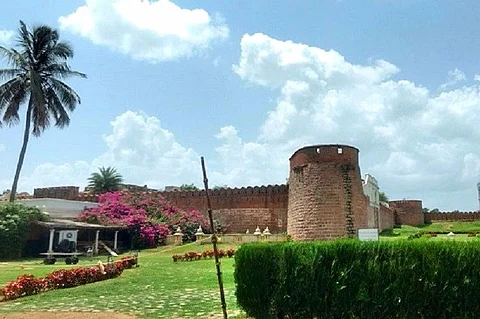

To get away from the din of Hyderabad city, follow National Highway 44 for 120km, then journey past the green fields of Kamareddy until you get to the giant rampart, made of granite boulders. This is Domakonda Fort, once home to royalty dating back to the 10th century.
But for decades the fort remained forgotten. In 2012, however, Domakonda Fort came back into the spotlight after Telugu actor Ram Charan Teja’s wed his long-time girlfriend Upasana Kamineni, who is the granddaughter of Kamineni Umapathy Rao, a former royal.
Spread across 30 acres, the fort houses a palatial building called the Addala Meda or the Glass Palace. Also known as Khila or Gadi, the fort has been constructed on a circular plan, with two entrances – one on the east and another on the west. The fort also has four bastions, which are presently in a dilapidated state.
The influence of Saivism is distinct in its architecture, with an 18 pillar Shiva temple situated in the fort. The height of the granite fortifications highlights Fort Domakonda’s defence capabilities, protecting its erstwhile rulers from the threat of invaders. The kandakams (traps), which are now covered in thorny bushes, once kept enemies at bay.
The main entrance to the fort is through a strong wooden door with metal spikes, adding to its defences. Just a few steps from the main entrance is the Glass Palace or Addala Meda, a two-storied white bungalow with beautiful stuccowork on its facade. Built in the 1920s, the Glass Palace is the jewel in Domakonda Fort.
History
Historian Rammoorthy Sharma, who has traced its history says, “Domakonda Fort was initially constructed by the Rashtrakutas in the mid 10th century, with many dynasties taking control over it over the years.”
By the early 13th century, however, the fort came into the hands of the Kakatiya rulers and was under their control until the 17th century.
Domakonda Fort was then transferred to the Kamineni royal dynasty, whose political capital was Bikkavolu(the present Bhiknoor), less than 15 kms from the fort. Sharma, however, observes that there is no historical evidence to show that there was battle between Kamineni and Kakatiyas.
Several scholars believe that the Kakatiya rulers gave Domakonda Fort to the Kaminenis, who were sub-rulers. Raja Kamareddy, a Kamineni, was in good terms with Kakatiyas and ruled under their guidance. The Kaminenis succeeded the Kakatiya dynasty and ruled until the early part of the 20th century,
Explaining the style of the structures inside the fort, Assistant Professor at Kamareddy Government College, Kumara Swamy says, "Rashtrakutas and Chalakyas were known for their uniqueness in constructing monuments,"Vesara" is an art form which specifically followed by these rulers."
On the influence of Islamic architecture, Swamy points out, “During the 17th century Mughal emperor Aurangzeb also maintained trade relations with this area. The fort was taken over by the Nizam, with the Kamineni as a sub-ruler. Under his royalty, there may have been an influence of Islam on architecture.”
He also observes, “Another fort in neighbouring Sirnapalli was ruled by Seelam Janaki Bai, the only woman ruler from the Sirnapalli dynasty, a landlord family with acres of agricultural land. They competed with the Kaminenis in welfare and development programmes. The present Secundrabad and Nanded railway lane was Seelam Janaki bai's legacy, with her diplomacy she managed to get a railway line through her territory while Domakonda rulers failed to do so."
So why did the Kaminenis leave the fort?
Rammoorthy Sharma explains, "Some of these royal men started living a very luxurious life and they started getting used to the Hyderabad Nawabs’ lifestyle. At the same time, there was a huge upsurge in the Telangana Peasant Armed Rebellion and Sreekakulam Armed Peasantry Rebellion. This may have led to the Kaminenis relocating to Hyderabad and some others went abroad.”
With Domakonda receiving a number of visitors, the state’s Archaeological Department had called for tenders to help conserve and restore the fort. However, while their efforts went in vain, the Kamineni family has for now begun renovating the fort to restore it to it to its past glory.